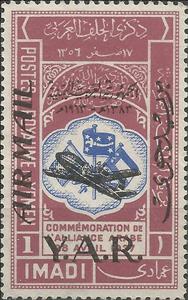Stamp: The Anniversary of the Revolution Overprinted "Y.A.R." a (Yemen, Arab Republic 1963)
The Anniversary of the Revolution Overprinted "Y.A.R." a (Yemen, Arab Republic 1963)
01 September (Yemen, Arab Republic ) within release The Anniversary of the Revolution - Airmail goes into circulation Stamp The Anniversary of the Revolution Overprinted "Y.A.R." a face value 40 Yemeni buqsha
| Stamp The Anniversary of the Revolution Overprinted "Y.A.R." a in catalogues | |
|---|---|
| Michel: | Mi: YE-AR 309A |
| Yvert et Tellier: | Yt: YE-AR PA5 |
| Stanley Gibbons: | Sg: YE-AR 230 |
Stamp is square format.
40 Yemeni buqsha - 1 Yemeni imadiStamp The Anniversary of the Revolution Overprinted "Y.A.R." a it reflects the thematic directions:
An aircraft (pl. aircraft) is a vehicle that is able to fly by gaining support from the air. It counters the force of gravity by using either static lift or the dynamic lift of an airfoil, or, in a few cases, direct downward thrust from its engines. Common examples of aircraft include airplanes, rotorcraft (including helicopters), airships (including blimps), gliders, paramotors, and hot air balloons.Part 1 (Definitions and Abbreviations) of Subchapter A of Chapter I of Title 14 of the U. S. Code of Federal Regulations states that aircraft "means a device that is used or intended to be used for flight in the air."
An anniversary is the date on which an event took place or an institution was founded in a previous year, and may also refer to the commemoration or celebration of that event. For example, the first event is the initial occurrence or, if planned, the inaugural of the event. One year later would be the first anniversary of that event. The word was first used for Catholic feasts to commemorate saints. Most countries celebrate national anniversaries, typically called national days. These could be the date of independence of the nation or the adoption of a new constitution or form of government. The important dates in a sitting monarch's reign may also be commemorated, an event often referred to as a "Jubilee".
Aviation is the practical aspect or art of aeronautics, being the design, development, production, operation and use of aircraft, especially heavier than air aircraft. The word aviation was coined by French writer and former naval officer Gabriel La Landelle in 1863, from the verb avier (synonymous flying), itself derived from the Latin word avis ("bird") and the suffix -ation.
A flag is a piece of fabric (most often rectangular or quadrilateral) with a distinctive design that is used as a symbol, as a signaling device, or as decoration. The term flag is also used to refer to the graphic design employed, and flags have since evolved into a general tool for rudimentary signalling and identification, especially in environments where communication is similarly challenging (such as the maritime environment where semaphore is used). National flags are patriotic symbols with varied wide-ranging interpretations, often including strong military associations due to their original and ongoing military uses. Flags are also used in messaging, advertising, or for other decorative purposes. The study of flags is known as vexillology, from the Latin word vexillum, meaning flag or banner.




